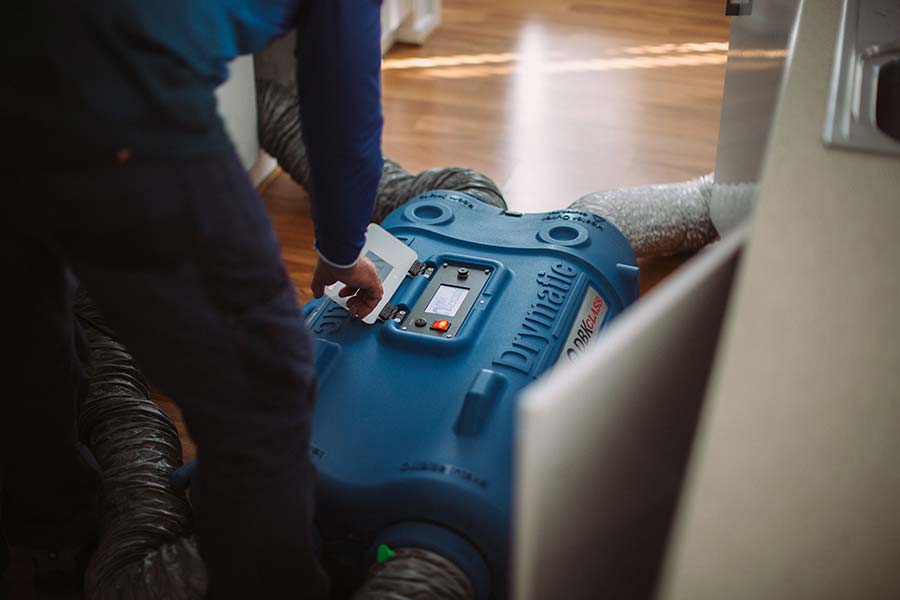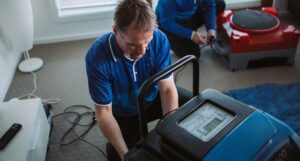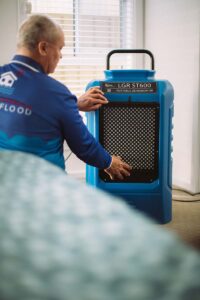Drying Water Damaged Structural Materials On The Gold Coast
When water invades your Gold Coast property, the immediate visible aftermath often captures your attention: saturated carpets, stained walls, and ruined furniture. However, the true, insidious threat of water damage frequently lurks far deeper—within the very structural elements that form your building’s foundational integrity.
Grasping what these structural materials entail and why their thorough, professional drying is non-negotiable after water exposure is paramount for safeguarding your property from enduring harm and potential health hazards.
This blog will illuminate the critical necessity of comprehensively drying your building’s structural components, detailing the significant risks inherent in leaving them damp.
We’ll also explain how Flood Fixers on the Gold Coast—a IICRC-accredited water damage restoration company—leverages cutting-edge drying methodologies to meticulously protect the longevity and safety of your property.
What Are Structural Building Materials?
Structural materials are the foundation of a building that provide the integrity, strength, and stability. These include:
-
-
Timber frames , bearers and wall studs
-
Concrete footings, slabs and sub-floor
-
Timber or particle board sub-floors
-
Brick or masonry walls
-
Joists, beams, and roof supports
-
Drywall & gyprock sheeting
-
These structural materials are built & designed to last a lifetime, however when they are exposed to water damage and increased moisture they become susceptible to premature decay and are at the risk of permanent water damage. This is why proper structural drying and remediation of these materials back to pre-loss condition is vital after a water damage event has taken place.
Why Is Structural Drying On The Gold Coast So Important?
Structural drying is even more important in coastal areas such as The Gold Coast due to the raised humidity levels that these coastal areas often attract. When you have this raised humidity combined with increased moisture levels, you have a recipe for mould and ongoing structural issues within the water affected property.
After a water damage event has taken place, it’s never enough to just provide a surface clean or replace carpets only. Moisture often seeps deep into structural materials, where it becomes trapped and often invisible to the naked eye. If left untreated, this can result in the following issues:
1. Unwanted Mould Growth
Mould growth thrives in damp, dark, un-ventilated areas such as inside wall cavities & underneath floorboards. Once mould takes hold in timber or gyprock, it can spread rapidly, this can also lead to an unhealthy indoor environment,affecting indoor air quality and posing serious health risks.
2. Structural Water Damage Deterioration
The integrity of all structural building materials can become compromised, leading to rot and decay of timber framing, tiles can weaken and begin to crack, concrete sub-floors can be affected and take a long period of time to regain full strength, gyprock wall can warp and lose integrity.
3. Structural Material Breakdown
Plasterboard, internal insulation, and other structural building materials start to break down once they have been saturated and remain wet for a period of time. This can lead to blistering paint, buckling of walls, or cracking ceilings—all of this can be very expensive to repair if not addressed early.
4. Increased Water Damage Repair Costs
Avoiding and not acting immediately on structural drying issues can often lead to hidden moisture damage & raised humidity which can remain undetected for weeks and even months in some cases. This often results in far more extensive and costly water damage repairs down the track.
How Flood Fixers Tackles Structural Water Damage Drying on The Gold Coast
Flood Fixers, specialises in structural water damage drying on the Gold Coast targeted to completely remove hidden moisture from deep inside all water affected your building materials. Our structural water damage drying process includes:
✅ IICRC- Accredited & Certified Technicians
Flood Fixers follow strict structural drying processes as outlined by the Institute of Inspection Cleaning and Restoration Certification (IICRC)—the universal standard in water damage restoration.
✅ Hi-Tech Moisture Detection
With the professional use of the latest thermal imaging cameras and sensitive moisture meters Flood Fixers identify trapped moisture inside wall cavities, floors, sub-floors and ceilings.
✅ State Of The Art Drying Equipment
From commercial grade, powerful (LGR) dehumidifiers, Hepa filtered air scrubbers , high velocity air movers to the very latest heat drying processes Flood Fixers Gold Coast use professional equipment to achieve outstanding structural drying results even in difficult-to-reach areas and even the most flood affected properties on the Gold Coast.
✅ Targeted Structural Drying Gold Coast
Every property is different, the Gold Coast is known for high humidity levels therefore Flood Fixers target humidity reduction when conducting structural drying on The Gold Coast. We create a hot, dry environment within the flood affected property to facilitate the required structural drying.
The Long-Term Benefits of Proper Structural Drying On The Gold Coast
-
Stops mould growth and prevents future mould outbreaks
-
eliminates any ongoing structural damage to the property
-
Saves costs on any future or immediate building repair costs
-
Maintains your property’s integrity and value
-
Helps with a speedy water damage Insurance claim process
❓ Frequently Asked Questions (FAQs)
1. Can I just use normal fans or heaters to dry the water affected structure myself?
No, domestic fans or heaters only dry the surface, industrial grade dehumidifiers and specialised heat drying equipment is required to effectively dry water damaged structural materials.
2. How long does it take to dry structural materials after water damage on The Gold Coast?
Structural drying time frames depend on the affected materials, amount of water saturation, and indoor environmental conditions. In most cases, structural drying can take 3–8 days with intensive structural drying close water damage monitoring.
3. Will mould set in if I don’t dry the wet structural materials?
No, not always, but it is highly likely. Mould can begin to develop in as little as 24–48 hours in damp, wet areas, especially inside wall cavities and underneath sub-floors.
4. What are the warning signs that dampness & moisture are still trapped in structural materials?
Common signs of trapped moisture in structural water damaged materials include:
-
Strong musty odours
-
Discoloration and water staining on walls
-
Buckled floors and warped walls
-
Ongoing visible mould growth
5. Why choose Flood Fixers for structural drying on The Gold Coast?
Flood Fixers are locals with qualified water damage restoration technicians based on The Gold Coast, IICRC-certified, and have extensive experience in structural drying across the Gold Coast. We use industry-leading methods and techniques to ensure your home is dried safely, thoroughly, and quickly and is free from the risk of any future mould outbreaks due to the water damage event.
📞 Need Expert Help with Structural Drying on the Gold Coast?
Don’t leave your property’s structure at risk of ongoing building issues. Whether you’re dealing with burst pipes, storm damage, or flooding, Flood Fixers is here to help.
Our team provides fast emergency response, expert water damage assessments, and professional structural water damage drying on the Gold Coast to restore your property to pre-loss condition and prevent long-term damage.




